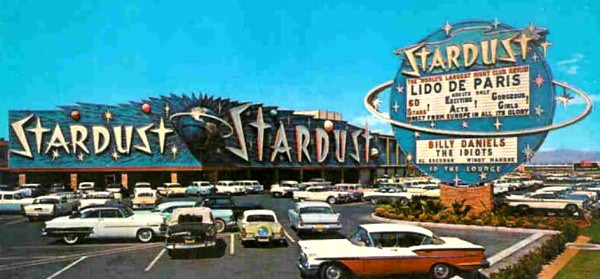
Photo from the Don Boyer Collection
| Stardust Hotel & Casino |
| 3000 Las Vegas Blvd South |
| 1955 - 2007 |
 Photo from the Don Boyer Collection |
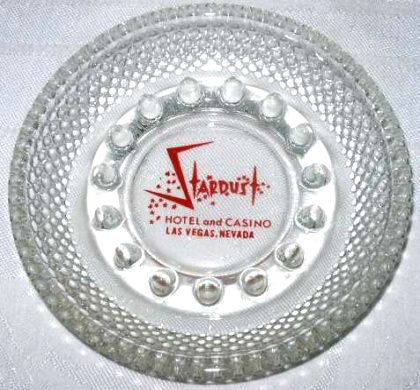 Don Boyer Grade 2 |
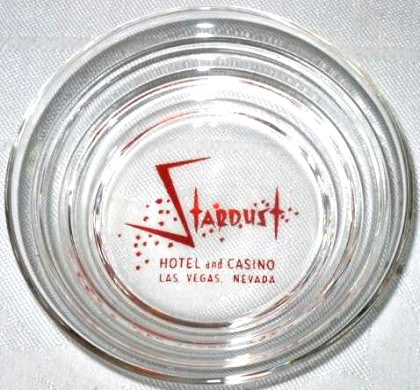 Ross Conquest Grade 2 |
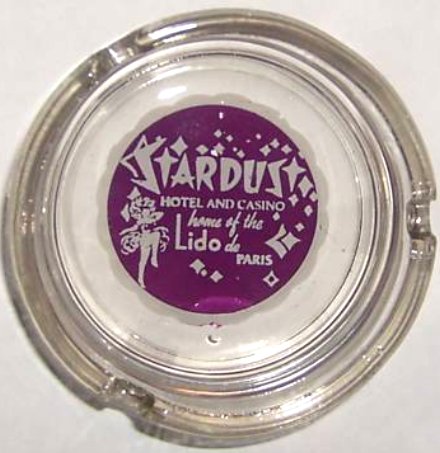 Don Boyer Grade 2 |
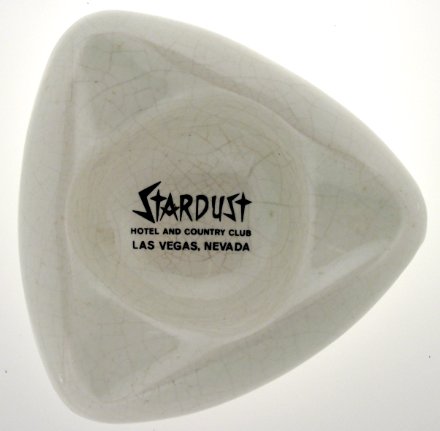 Michael Richter Grade 2 |
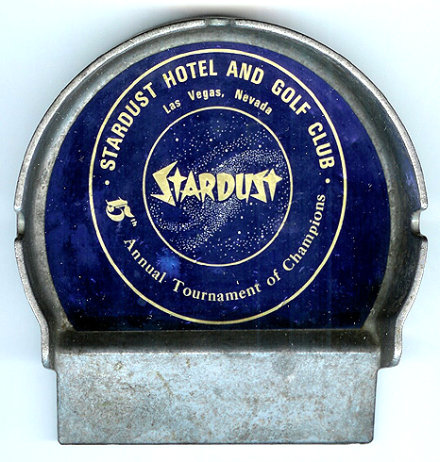 Louie Elioupoulos Grade 2 |
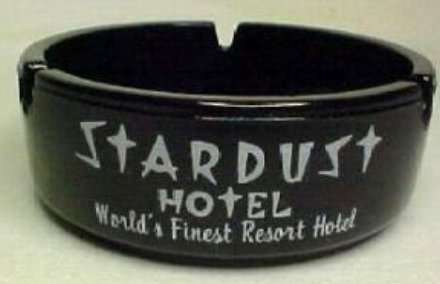 Michael Richter Grade 1 |
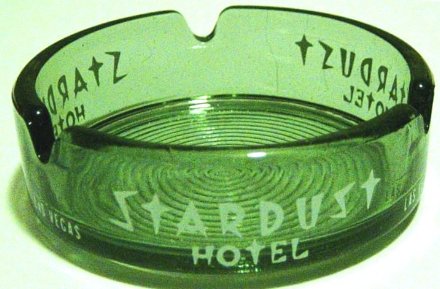 Walt Akin Grade 2 |
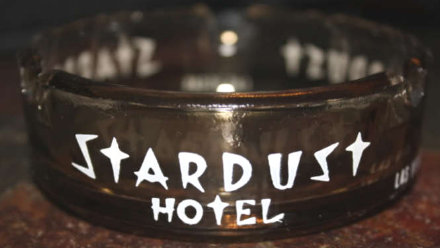 Walt Akin Grade 2 |
The Stardust The thirteenth resort on the Strip Anthony Cornero Stralla He was better known as Tony Cornero. Cornero made his first fortune during prohibition; his specialty was overseeing the unloading of illegal booze from large ships waiting off of the California coast, to smaller boats that would get the booze to shore before dawn. Cornero was caught, convicted of a felony, and did time. Then prohibition was repealed, so he had to find another occupation after his release from prison. Tony, with his brothers Frank and Louis, headed for Las Vegas. Early in 1931, Tony and his brothers built the Meadows Casino, near the intersection of Fremont and Charleston. It was reportedly the first "classy" casino in town (as opposed to "sawdust joints", which appropriately described most of the early casinos). Most of the guests were local, they didn't need hotel rooms so, only two months after it opened, the Corneros sold the 30-room hotel but retained the casino. On labor day, 1931, the hotel burned to the ground. The Corneros kept the casino until 1932. That was the end of Tony's first venture in Las Vegas. Tony headed for California, where he ran gambling ships, including the SS Rex. There were constant battles with state and local officials, sometimes literally, sometimes figuratively. At least one time, when officials tried to board the Rex, Tony's crew sprayed fire hoses at them, to keep them at bay! Eventually, though, deputies did board the Rex. They axed roulette wheels, threw craps tables overboard, and enjoyed taking pictures of the mayhem. Tony took his battle all the way to the California Supreme Court, claiming that his business was legal, but eventually he lost the war. So, for awhile, Tony ran a legitimate shipping company. In 1944 Tony headed for Las Vegas again. He leased the casino in the Apache Hotel building, downtown, and changed the name to the SS Rex. We've been told that the light fixture (which looks like carvings of Neptune) over the main bar at Binion's was removed from the SS Rex ship, and was installed in the SS Rex Casino by Tony Cornero. There were, of course licensing problems for Cornero. Several months after the SS Rex opened, the landlord severed all connections with him. Once again Cornero headed for California, to operate the SS Lux off shore. Once again, he found himself battling with officials. Once again, he lost. If at first you don't succeed… In the early 1950's Tony Cornero was in Las Vegas again, preparing for his third venture into the Las Vegas gambling scene. This time he would go all out…he didn't want his hotel to have just 200 or 300 rooms, like most of the new hotels had when they opened. No…his hotel would have 1500 rooms! Each section of rooms was to be named after a planet, and there would be a space-age motor scooter to carry the guests to their rooms. The hotel would cover 40 acres of land…the world's largest hotel! The hotel would be called Stardust. (There is some indication that Cornero originally planned to call his resort Starlight. I couldn't find much, but I saw one ad with that name). In 1954 Cornero bought 36 acres of land next to the Royal Nevada. He set up a company that he called Stardust Inc., then printed up stock certificates, which he sold to his investors, at $10.01 a share. Of course, he hadn't registered the stock with the Securities and Exchange Commission, but that was just a formality…wasn't it? He got the money; the customers got the stock certificates, and construction began. Simple enough. If money ran a little short, sell a few more certificates. He ended up selling some $4 million in unregistered stocks. Not being registered, the stocks weren't underwritten. Ultimately stockholders took the case to court, where the judge ruled that Nevada residents who'd bought stock could keep their ownership, non-residents lost their investments. Tony Cornero paid cash as he went. A truckload of materials was delivered…he paid cash. Construction workers worked…he paid cash at the end of the week. He went over to the Desert Inn to shoot some craps…he paid cash. There was a lot of construction going on in Las Vegas in the 1950's (that's one thing about Vegas that hasn't changed!) and there weren't enough skilled workers to go around. It took a lot of time to build something the size of the Stardust, but Tony was anxious to see his dream turn into reality. He began paying union laborers double wages, to get the job done faster. Of course, double wages plus materials and some gambling (a man had to have an outlet at the end of a long day, didn't he?) meant that the money started to run out. In 1955 Tony set up the first of several meetings with Moe Dalitz and Meyer Lansky. He needed money to finish the Stardust, which would be the world's biggest hotel and the world's biggest casino, and he would be willing to take them in as partners. Over time, they loaned him several million dollars, so progress could continue. Of course there was a small matter of a gaming license. Tony was a convicted felon. He'd previously been denied a gaming license; later he'd received a license, only to have it revoked. Apparently Tony was an optimist, because he went before the Gaming Control Board once again. Once again, he was denied. He'd gone too far with the project to abandon it, and he struck an agreement with Milton "Farmer" Page, who was licensed as an owner of the downtown Pioneer Club. Of course, Farmer wanted to manage the casino his way, and Tony wanted to make his own decisions…but all that could be worked out later, at least there was a license. Then, on the morning of July 31, 1955, while shooting craps at the Desert Inn, Tony Cornero clutched his chest, collapsed and died. Some say it was a heart attack. Others speculate as to why the glass he'd been drinking from was whisked away to the kitchen to be washed, and why it was two hours before anyone called the Sheriff. There was no autopsy. Whatever the cause…at 55 years old, Tony Cornero crapped out. The Stardust was about 80% complete when Tony died and construction stopped. Construction workers hadn't been paid for two weeks, and no one knew who was in charge. The hotel was boarded up and fenced off, and stayed that way for nearly two years. A creditor's committee moved in to try and straighten out the mess in Federal Bankruptcy Court. Finally Mrs. John Factor, sister-in-law of cosmetics magnate Max Factor, was allowed to purchase the Stardust. The Factors were the backers for Dalitz & Company, who would officially assume control in September of 1958. The Stardust's plans were revised, somewhat, and work began again. A dream comes true…finally On July 2, 1958, nearly three years after Tony Cornero died; the Stardust opened at 3000 Las Vegas Blvd. South. It opened with 1032 rooms that were advertised as "Astronomical luxury at down-to-earth prices" (rates started at $6 per day). The Big Dipper swimming pool was 105 feet long; the casino was 16,500 square feet; the lobby was 13,500 square feet and was decorated in rich red and deep brown colors with indirect lighting. The Café Continental theater-lounge had seating for 700. The resort opened with the French revue Lido de Paris, starring Jacqueline Du Bief. The most noticeable thing about the 'Dust was the sign on the building; it was a 216 foot long "galaxy" that weighed 29 tons, and used 7,100 feet of neon tubing and 11,000 lamps to create a glow that was visible from 3 miles away! The Stardust offered the largest casino in Nevada (probably the largest in the country). In addition there was the Stardust Country Club four miles to the east, The Stardust International Raceway was to the west of the property, the Stardust bought a drive-in movie theater that had closed and it was reopened as the Stardust Drive-In. They even offered a supervised playground for the youngsters, and riding was available at Horseman's Park, on the Stardust grounds. When the adjoining Royal Nevada went bankrupt, the Stardust bought it, thus adding more rooms and another swimming pool. The Royal Nevada's casino was turned into the Stardust Auditorium/Convention Center. The Stardust was successful. It seems that Tony Cornero's dream came true, even though he wasn't around to see it. The 1970's In 1969 the Los Angeles based Parvin-Dorhmann Corporation bought the Stardust. Ashtrays and postcards of the time say "A Recrion Resort"; Recrion was an offshoot of Parvin-Dorhmann. In the early 1970's they had the 'Dust up for sale, and along came developer Allen R. Glick. Glick came to Vegas in 1972 and purchased the Hacienda Hotel and Casino with the intention of tearing it down to build a mobile home park. He changed his mind, decided to run the Hacienda himself, and applied for a gaming license. His application was approved. He found out that the Stardust and the Fremont Hotel (downtown), both owned by Recrion, were for sale. He approached Al Baron, assets manager of the Central States Teamster Pension Fund, for financial backing. Baron tried to warn him that "business partners" came along with teamster money, but Glick persisted. By 1974 Glick owned the Stardust and Fremont, and the Chicago mob owned Allen Glick. "Lefty" Frank "Lefty" Rosenthal was a highly skilled sports handicapper, from Chicago. He'd been a professional gambler, he'd run his own bookie joint, and in 1971 he was hired by the Stardust as a floorman. Lefty was very smart, and when he saw the amount of cash that went through the casino, he began to get ideas on how to increase that cash flow even more. He told some "friends" that if he could get into a position of authority, there would be a big increase in the casino profits. When Glick took over the Stardust, his "partners" told him to promote Rosenthal, so Glick made him the Director of Nevada Operations, for the Argent Corporation. Then the Gaming Control Board entered the picture. Seems that anyone that holds an upper-management position in the casino industry had to be licensed by Gaming, as a Key Employee. Gaming told Glick that Rosenthal wouldn't get a license, period. Over the next several years Rosenthal had different titles at the Stardust, including food and beverage director and entertainment director. Rosenthal would hold a position for awhile, then Gaming would step in and say the position needed to be held by a licensed person. Finally, Rosenthal hosted The Frank Rosenthal Show; a television show that was broadcast from the Stardust. Regardless of his title, everyone (including Allen Glick) knew his real position…he was the Boss! One of the ideas that Rosenthal dreamed up was to add a race and sports book to the casino. Before 1975, race and sports betting was handled in small "bookie joints". In September of 1975, the Stardust opened an 8,000 square foot book, with plush chairs, multiple television screens, and numerous boards to display race results. Siegfried & Roy It was 1970 when Siegfried Fischbacher and Roy Horn came to Las Vegas for three years, to perform a 15-minute act in Donn Arden's Lido de Paris, at the Stardust. In 1973 they left Nevada to perform elsewhere, then they came back to perform at the MGM, in the Hallelujah Hollywood show, for the next several years. In 1978, learning that Siegfried & Roy's contract was up for renewal, Rosenthal wanted them back with the Lido. He sent Bernie Yuman, a "gopher" with ambition, to the MGM, promising him $500 if he could get the magicians to Rosenthal's office, for a meeting. There was 20 minutes left in the MGM's second show when Bernie ran out the door. Bernie managed to get into the magician's dressing room, and persuaded them to meet with Rosenthal. Rosenthal doubled their salary, and made sure the dressing rooms and animal quarters were all that the magicians requested. He also agreed to give them star billing, with the Lido, and allowed them to be the 30-minute closing act. They stayed at the Stardust until 1981, when they moved to the Frontier, to star in Beyond Belief. Skimming Rosenthal was in charge of a huge "skimming" operation that included both the Stardust and the Fremont. The "skim" was cash that wasn't included in the official count. If the cash wasn't counted, it wasn't reported. If it wasn't reported, it wasn't income. If it wasn't income, it wasn't taxed. Skimming started in the early days, when casino owners had to pay back loans that didn't show up on the books. If someone borrowed a million dollars from Meyer Lansky, it was a cash loan "just between us". The loan and interest had to be paid back in cash, off the books. Susie Berman, daughter of mobster Dave Berman, remembers going into the counting room with her father. She watched as the owners sorted money into stacks, by denomination, then divided it "three for us, one for the government, two for Meyer." The owners had to make a profit--that's why they were in business. Meyer had to be paid back, or the casino owner wouldn't stay in business. The government's stack would be counted, reported as income, and taxed. Everyone was happy with the set-up until the government figured out that they weren't getting their full share. The Government started making rules and regulations to try and clean up the casino industry. Agencies were set up to regulate licenses, and to oversee accounting procedures. Casino owners were no longer allowed in the count rooms. A Nevada Gaming Commission person was placed in the count room, observing the count and recording the figures for the government. As more government controls were put in place, less money was going to the mob…and the mob saw that as a bad thing. In the count room, the coins weren't individually counted they were weighed. The Stardust managed to adjust their scales to under-report the value of the coins on the scales. The coins that weren't included in the official count were rolled, then were placed in kiosks around the casino floor. Before the days of bill-validators, the change girls would sell rolls of coins to slot players. They would take the bills they received, and put them into the cash drawers in the kiosks, and take out more rolls of coins. At night more rolls of coins would be added to the kiosks, and the money would be removed from the cash drawer. None of that cash ever showed up in the counting rooms. It was estimated that $12 million a year was being skimmed, by this method. Rosenthal couldn't do everything himself. He needed someone to make sure that his orders were carried out. Tony "The Ant" Spilotro was the muscle-man that the mob sent to Vegas to fill the role. Useful when he arrived in Vegas, Spilotro eventually proved to be a hindrance. He had an affair with Rosenthal's wife, he got involved with drugs, and he set up a burglary ring. He was drawing unwelcome attention to Frank Rosenthal and the Stardust. Rosenthal tried to keep him away, but Spilotro felt that he was beyond taking orders. In 1982 a car bomb blew up Rosenthal's car, in an attempted murder. Rosenthal's estranged wife died later that year, from a drug overdose. Spilotro was arrested for heading up the burglary ring. The Feds were closing in. By 1983 the state had suspended the gaming license of Argent, pending revocation of the license. Rosenthal was listed in the "Black Book", the state Gaming Commission's list of persons who were officially barred from entering any Nevada casino. He moved to California. Other mob bosses were arrested and some did time in prison. Spilotro and his brother were found, a few years later, beaten to death and buried in a shallow grave in the middle of a cornfield in Indiana. For more of the story of the mob-controlled Stardust, get the movie Casino. It was based on the book of the same name, that was written by Nicholas Pileggi, which tells the story much better than I ever could. The names have been changed, but the story is there. The Boyd Group The state removed Argent from controlling the casino, but they didn't close the Stardust. The state asked Boyd Gaming to come in and manage the casino, while hearings were held to determine whether Argent could stay in gaming. Argent retained control of the non-gaming areas. Initially Argent gave Boyd a hard time, but they became more cooperative after time, realizing that they were reaping the profits of Boyd's management. Boyd Gaming received only a flat fee for managing the casino. Boyd had been managing the Stardust for about a year when an Argent attorney approached them. Argent had lost their license, and felt that they would lose their appeal. They wanted to know if Boyd was interested in buying the Stardust and the Fremont, which was also owned by Argent and was involved in the skimming operations. Boyd agreed and on February 28, 1985 ownership officially changed hands. In 1988 Boyd spent $50 million to expand and renovate the property, and in 1991 they added a 32-story hotel tower. On February 28, 1991, the Lido de Paris show took its final bow, after being part of the Stardust since 1958. Twelve totally different versions of the show had been produced in France, then sent to the Stardust. Nearly all of the early performers came from France, with the shows. Later versions of the show used mostly American performers. The costumes were designed and created in France. As each version of the show ended, the costumes and scenery were taken out into the desert and burned, under the supervision of Federal Agents, to avoid paying import taxes on them. In 1993 Sam Boyd passed away, which left Boyd Gaming in the hands of his son, Bill. In that same year, Boyd Gaming went public. In 2006 it was announced that the Stardust would close, to make room for Echelon Place. Echelon Place will be built on 63 acres and will include the 2,600-room Resort Tower and the Suite Tower with 700 suites. Two spas are planned, two theaters and more than 25 bars and restaurants. There will be landscaped pools, shopping and more than a million square feet of meeting and convention space. Three additional hotels are expected to be part of the property, each with additional amenities. Opening is scheduled to be 2010. |
First published in the Casino Chip and Token News Magazine Spring 2008, Volume 21 number 1 issue. Casino Chip and Tokens News is the official publication of The Casino Chip and Gaming Token Collectors Club, Inc. Special Permission was granted to reprint this information. All rights are reserved by the CCGTCC. If interested in joining this fascinating collecting field and receiving the clubs award winning magazine, go to www.ccgtcc.com and select membership. |
The Great Stardust Skim This is such a wonderful American success story. In 1976 the president of the Stardust Hotel was 34-year old Allan Glick. Seemingly out of nowhere, this nice clean-cut young man and head of the ARGENT Corporation secured a Teamsters loan for about $146 million that enabled him to take over the Stardust Hotel and Casino. The ARGENT name was an abbreviation of Allan R. Glick Enterprises. The timing on this loan was very important. By 1976, many of the Las Vegas casino "cash cows" the Mob throughout the country depended on were beginning to dry up. Between the Federal Government and the state of Nevada, it was becoming more and more difficult for a mobster to make a decent living. The Chicago Outfit still had control over the Stardust, Marina, Fremont and Hacienda, but it became necessary to increase the size of the skim to make up for other lost business. Let's take a moment to discuss the meaning of the word "skim". It isn't stealing in the usual sense. It isn't taking money that belongs to someone else. Skimming is hiding money from Uncle Sam. Every time a dollar would come into the casino, it had to be reported to the government. So at the end of the year, when the Stardust would do its 1040-EZ or whichever form they used, they would have to pay income tax on every penny the casino took in. How much more profitable would it be if the US Government and Nevada State Revenue people just didn't know how much money the Stardust and the other hotels had actually made? ("Wow! What a good idea! That way, we could get to keep a lot more money, right boss?") In the old days in Las Vegas this was pretty easy to do. A casino owner could wander into the "soft count room" where the bills were counted, take a few handfuls of the big ones, put them in his pocket and then go have a cup of coffee and a Danish..Who was going to stop him? He owned the place. This was his money. He wasn't stealing. He just wanted to take a few thousand bucks as "walking around money." What Uncle Sam doesn't know ain't gonna' hurt him. Then the hotel owner could find a nice corner on a hot-looking craps table, call Tony D., the pit boss there at craps pit 3, have Tony D. bring him a marker for "10 large," and get $10,000 in chips. He'd play a few minutes, lose a couple of thousand, scoop up the remaining 8 G's in chips, take them over to the cashier and cash out. When his signed marker arrived in the accounting department, his girlfriend, Lola, would take the $10,000 marker and put it in her pocket. ("Honest, she's not my girlfriend, sweetheart, I hardly know the woman"). And that was that. No marker means no money owed the casino, right? It's his money anyway, right? Who is he stealing from-himself? Believe it or not, this very simple method of taking a few million dollars out of the Las Vegas hotels would work, year after year after year. Then the Nevada Tax and the Gaming Commission boys set down some rules. Damn spoilsports! Rule Number 1-An owner is never allowed in a counting room. Rule Number 2-An owner is never allowed to play at his own hotel. Rule Number 3-All money that comes into a casino, I reiterate, 100% of the money, has to be reported as income. The US Government trained its eyes on the casino business through the Organized Crime Commission, the Kefauver Committee and, later, the Church Committee. Despite all the Fed's money spent on all the investigations of the Las Vegas hotels and their owners, the only thing they could get the owners on was good old tax evasion. Skimming money means taking money from the pot before Uncle Sam has a chance to count it and tell you how much tax you owe on it. If the money can't be accounted for, it can't be taxed, plain and simple. The Chicago Outfit was faced with a cash flow problem. The answer presented itself in the Stardust, and Allan Glick. Nice, clean-cut Allan Glick and his partner, Gene Frisch, were both young men who were making a pretty fair living owning the Hacienda. Everything was above board and going along well until a company called RECRION, that then owned the Stardust, got into trouble. Without going into the personalities of RECRION, the company was being forced to sell the Stardust. There was some silliness about money from the Stardust Hotel finding its way on a weekly basis to Joey Aiuppa of the Chicago Outfit, Moshe Rockman of the Mayfield Road Gang in Cleveland, and to Frank Balistieri of the Milwaukee Mafia. Both Cleveland and Milwaukee in the mid-1970s were subsidiaries of the Chicago Outfit, which was run by Joey Aiuppa. Right up until June 19, 1975 Sam "Momo" Giancana had run Chicago. However, Momo wasn't the best of bosses of the Chicago Outfit. He was very high visibility, with his flamboyant personality, and his highly publicized affair with Phyllis McGuire. Then there was his friendship with Frank Sinatra, and with Judy Campbell, and with the Rat Pack...he was just too visible for the old school dons. On top of everything else, their money stream, Las Vegas, became delivering less and less money. Enough was enough. In the basement of his Oak Park, Illinois mansion, Momo made himself a before bedtime snack of Italian sausage and peppers...and he died. After his snack, at the top of the stairs, a gunman was waiting for him, and shot him six times in the mouth. Joey Aiuppa became capo of the Chicago outfit. No such things as a "honeymoon period" for Joey Aiuppa either. The Feds and the Nevada State Gaming Commission, who were both developing real power in Nevada, were beginning to make daily visits and phone calls to Aiuppa. It seems all they wanted to talk about was the Stardust. The question of real ownership of the Stardust, which had been hidden for many years, was beginning to bubble to the surface. At the same time, Allan Glick, who had just turned 32, was beginning to make quite a few bucks at the Hacienda. He decided he wanted to make even more money if he could only figure out a way to do it. Talk about a fortuitous set of circumstances. Here were the owners of the Stardust being told to get out or lose their license, and here was Allan Glick, a nice, clean cut young man, who wanted desperately to get into the big time. So Allan let it be known all over Las Vegas that he wanted to buy the Stardust. His big problem was that he didn't have the money to buy it. But he let it be known, "If anyone wants to lend me the $100 million to buy it, I wouldn't say no." So one day, Allan got a phone call at his Hacienda office from Del Coleman, the largest stockholder in the RECRION Corporation. Coleman, besides his RECRION affiliation, was also the unofficial representative of the Teamsters Union and the Chicago Outfit in Las Vegas. That meant he watched over their business affairs. Del Coleman said, "Allan, we got somebody you should meet," and Allan was introduced to the boss of the Milwaukee Mob, Frank Balistieri. Balistieri said he could help Glick get a loan. A friend of his was an official at the Teamsters Central States Pension Fund. Sam Giancana had called Balistieri and told him to help Glick get the money he needed to buy the Stardust. Then Glick started getting calls from some of the other Mob families, all wanting to be helpful to Glick in getting the Stardust loan. One call came from Kansas City. Glick was told the caller knew another Central States Teamsters official who could help arrange the loan. Then more calls came into Allan Glick's office from very well-connected and very friendly men from Cleveland and Chicago. And believe it or not, just like in the movies, the money started coming in. Before long, our hero, Allan Glick, had enough money to buy the RECRION Corporation along with all of its assets including the giant Stardust Hotel. And all for next to no money out of his own pocket! Nearly $140 million was raised to install this nice young man as owner of the Stardust. What a wonderful country we live in! Glick's predecessor at the Stardust was a man named Al Sachs. During the changeover, Sachs went to Paris to renew the contract on the amazingly successful Lido de Paris show. He got the new contract signed, but returned to find his office furniture in the hall. The transition was now complete. (This is a bit of an oversimplification on how Allan Glick, at the ripe old age of 34, actually got control of the ARGENT Corporation and the Stardust Hotel. But actually, that's pretty damn close to exactly how it did happen). With Chicago's assistance, Glick became the new president of the ARGENT Corporation and owner of the four hotels. He packed his bags and moved from the Hacienda to the Presidents Suite at the Stardust. On his first day at his new job, Glick hired bookmaker-deal maker-odds-maker Frank "Lefty" Rosenthal to be his assistant at a salary of "250 large," Two Hundred & Fifty Thou A Year! That same day, Lefty replaced Bobby Strella, who was a pretty good casino boss at the Stardust, with a fella' whose previous job experience was owner-operator of the gift shop at Circus Circus, which he purchased for peanuts. The gift shop at Circus Circus was given as a favor to one of Momo Giancana's friends from Chicago at a "friends and family" price of $70,000. It was worth over $2 million. It was purchased by Momo's friend Tony. When Tony was at Circus Circus, he was Tony Stewart, but when he moved to the Stardust he went back to Tony Spilotro. Spilotro was a hit man, a street-enforcer and Mob killer who worked for the Chicago Outfit. He had been sent to Las Vegas a few years earlier by Sam Giancana to learn the city and to watch out for Chicago's interests there. The movie Casino starring Joe Pesci as the Tony Spilotro character and Robert De Niro as Lefty Rosenthal was one of the better Las Vegas mob movies. OK, RECRION was out as owners of the Stardust. They were bought out, not kicked out, and they were pretty happy with their $30 million or so of profit. Sure, a few of them had to go to prison, but overall, it was a pretty good ownership transition. But then there was a problem with Rosenthal's position as Stardust general manager. Lefty had a "past." He was a known associate of the Mob and had a conviction on his police record for fixing a basketball game some years earlier. Rosenthal's conviction, however, was conveniently removed from the record before he arrived in Las Vegas. But the guys who made up the Nevada Gaming Commission knew gambling and gamblers, and Lefty Rosenthal had a widely known reputation. On the second day of Rosenthal's new job at the Stardust, the gaming authorities called Allan Glick and advised him that Lefty was never going to be given the "key employee" designation-ever. By the mid-1970s the Nevada Gaming Commission, commonly referred to as the NGC, said that every employee who worked in a key position within a casino that had a gambling license was going to be called a key employee. As a key employee, they, too, had to have a gambling license. Allan Glick had to tell this news to Rosenthal. Glick was perfectly aware that Lefty was fully running the Stardust, even though he'd only been on the job for two days. Glick ran around until he found Lefty and told him the news. What's in a title, right? Lefty gave up his position as general manager/casino manager and became the Stardust Hotel's poker room coordinator. As a lowly poker room coordinator, chances are he wouldn't have to get that stupid key employee designation from the Gaming Commission. He was still making his $250,000 and he still absolutely oversaw every single detail at the Stardust. Just to make it look even more presentable to the gaming guys, Rosenthal took over one of the poker tables as his permanent office. No one else sat there. It was in the back of the poker room with a phone on the table, and he worked there right in the open. The Nevada Gaming Commission then told him that he couldn't be the poker room coordinator, either. It seems the NGC had just made Las Vegas poker room coordinators key employees as well. Not to be outdone, Lefty became the assistant entertainment director of the hotel for a while, and when those bureaucrats at the NGC said "no" to that, he became the assistant marketing manager. When that was stopped, he began broadcasting a nightly show from the Stardust interviewing celebrities on a Las Vegas television channel. This ploy of musical jobs really did work for quite a few years. Lefty Rosenthal was running the Stardust Hotel, Tony Spilotro was taking care of the casino and any other problems that might arise, and Allan Glick was off playing golf down at La Costa on the California coast. Everyone seemed to be in place. Rosenthal had understood from day one what was expected of him. Chicago was deadly serious about making the Stardust and their other Las Vegas properties more profitable. There are two murders that take place during this story and the first one happens right about here. There was a friend of ours from the Chicago Outfit named Marty Buccieri, who worked as a Casino Boss at Caesars Palace. Marty had been instrumental at the beginning of Allan Glick's money search by introducing Allan to some of his friends in Chicago. Just a quick aside here. 25 years ago casino bosses on the Las Vegas Strip all dressed in the same uniform. It didn't matter if they worked at Caesars or the Hacienda, casino bosses always wore black silk suits, white on white shirts with either solid white or solid black silk ties, high polished black shoes and big gold cuff links. Just one of those Las Vegas "things"-it's the way things were done. Anyway, one day Buccieri showed up at the Stardust looking for Allan Glick. Marty was told that Allan probably was down in the coffee shop, or maybe still in San Diego, or "you might want to try the health club". Buccieri found Glick in the steam room and told him that he owes him money-a finder's fee. He said something like: "I put you together with my boss, and look at you now. You own this joint. It was me who got you the $100 million and I want my piece. And I want it by next week, capice?" Glick found Lefty Rosenthal, which wasn't all that hard to do. Lefty had taken over Glick's office in the executive suite. Glick told him about the meeting he just had in the Stardust health club with Marty and all the noise Buccieri was making. A week later, Buccieri was found sitting in the front seat of his car in the Caesars Palace parking lot. He had just left work, and someone was waiting in the back seat of his car, and popped him twice in the head with a 22-caliber pistol. A small time Las Vegas hood named Horton was arrested for the murder, he said that he shot Buccieri because he "wised off at me" however, word on the street has always been that it was because of the pressure he was trying to put on ARGENT through Alan Glick for a finder's fee. Now, with Stardust completely in control of the ARGENT Corporation, it was time to institute The Great Stardust Skim. Here's how it worked. There was so much money coming into the "hard count" room every night, where the nickels, dimes and quarters were counted, that it was practically impossible to tally them even with the fastest change-counting machines in the world. The coins might not be totally counted, but they certainly could be weighed. The casinos purchased super sensitive scales that could weigh these coins very accurately. A thousand dollars in nickels, 20,000 nickels, could be weighed and the scale would register plus or minus two nickels. If the scales, however, were adjusted just a little, let's say 10% light, the number of unaccounted-for nickels, dimes and quarters, to say nothing of the $1 tokens in the same size and weight as silver dollars, would add up pretty quickly. Money from the slot machines were emptied into bags, placed in steel cages and rolled into the hard count room. You've probably seen those cages rolling around the casino attended by armed guards. They look like they are carrying a ton of money, which is pretty close. As money from the slots rolled into the count room, the ultra-sensitive scales were put to work. After the weigh-in, a small portion of the coins were recycled back onto the casino floor as rolls of coins that players could buy. The rest of the coins were put loose into bags for armored transport to the bank. It's here where the scheme begins. ARGENT owned four hotels: the Stardust, the Marina, the Fremont and the Hacienda. Each day the coins from the Fremont would be put into coin bags and taken by armored car to the Stardust. Coin bags from the Hacienda would also arrive at the Stardust by armored car. The bags would be opened and poured through chutes directly into hoppers located atop big scales. ARGENT hired a scale mechanic who would recalibrate these scales perfectly so when four thousand quarters ($1,000) where placed in the hopper, it only registered as nine hundred dollars. It was simple enough, $1,000 input and $900 output. "All right, if it's working so well on the quarters, lets recalibrate those machines over there that weigh the dollar tokens". The $900 in silver coins and dollar tokens was handled exactly by the book. Each roll was inspected and initialed by a Stardust employee as to accuracy. The tokens were recirculated onto the floor for resale and replay or were placed in the Stardust's bank account. But what do you do with the dollar coins and tokens? A few silver dollars can be passed at the grocery store to pay your bill, but not in great quantity. But try to spend one-dollar tokens from the Stardust that have the Stardust logo on them. There's not a lot of places anywhere except the Stardust that will take them from you. So what the heck are you going to do with all those tokens? Back in 1975, in every casino in Las Vegas with the exception of the Stardust, if you wanted change from the "change girls," they would sell it to you. Then they'd take your $20 bill, along with all the other bills, to the cashiers cage "employees only" window. They'd hand over the bills and get more rolls of coins in return. This was the standard way of dispensing coins in a casino. The Stardust, however, told their change girls that instead of going to the cashier's cage, they were to go to a few locked coin cabinets placed against the walls around the casino. With a key to the cabinet, they'd take the bills and dollar tokens, put them in the drop box inside the cabinet, take the correct number of rolls, and get back to work. The change girls knew damn well that the "honor system" required them to take the correct number of rolls each time. They also knew the cameras were watching them. To try to swipe a roll of coins was absurd, and they all knew it. What they didn't know was this cabinet situation was the backbone of a multimillion dollar skim, the largest casino skim ever uncovered in Las Vegas. And it only involved slot machines. Dozens of times a day, each change girl would open one of the coin cabinets with her key, deposit her money into the slot and take the right amount of wrapped coins. What they were taking was the 10% residue from the hard count room. Those coins that were not weighed by the ultra-sensitive scales, the one-dollar coins, were being turned back into fold able cash through this elegant little system of washing tons and tons of quarters and dollars. And there were literally tons of them. It was not unusual for one of these illegal coin boxes on the floor to have $10,000 in bills in it each evening when it was emptied. Additionally, an "extra" change booth was set up on the Stardust floor. For quite a few years it was never noticed by the State, like a toll booth set up on a stretch of two-lane road in the dead of night. It looked and operated just like all the other change booths, get in line and change your bills into coins, get in line and change your coins into bills. Except this change booth wasn't registered with any governmental authority. One hundred percent of the money that came in went directly to the coffers of Momo Giancana and the Chicago Outfit. These coin cabinets around the casino and the extra change booth worked for nearly five years. It finally came out in the 1979 and 1980 trials that the quarter and dollar skim was so successful at the ARGENT properties that the Chicago Mob was receiving $15 million per year for each of five years. That's $75 million in skim money shipped to the Mob without any tax being paid on it! As an aside to this story, there was a very sharp slot department manager working at the Fremont Hotel downtown. His name was Jay VanDermark. He was extremely valuable because he allegedly set up the entire skim operation there. All the little things necessary to take $300,000 per week out of the ARGENT properties were allegedly designed and implemented by VanDermark. One of the first things Lefty Rosenthal did after he was brought in was to move VanDermark from the Fremont to the flagship of ARGENT Corporation, the giant Stardust. VanDermark came in, managed the entire slot department, and watched over the day-to-day operation of the skim. As a special "thank you," Jay was given an all-expense paid trip to Mazatlan in Mexico. His head was bashed in while he was sunbathing on the beach in Mazatlan, and all the loose ends were now tied up. It's so nice when a plan works. |
First published in the Casino Chip and Token News Magazine Spring 2008, Volume 21 number 1 issue. Casino Chip and Tokens News is the official publication of The Casino Chip and Gaming Token Collectors Club, Inc. Special Permission was granted to reprint this information. All rights are reserved by the CCGTCC. If interested in joining this fascinating collecting field and receiving the clubs award winning magazine, go to www.ccgtcc.com and select membership. Steve Fischer’s fascinating book, “When the Mob Ran Vegas” can be purchased on line at www.whenthemobranvegas.com |